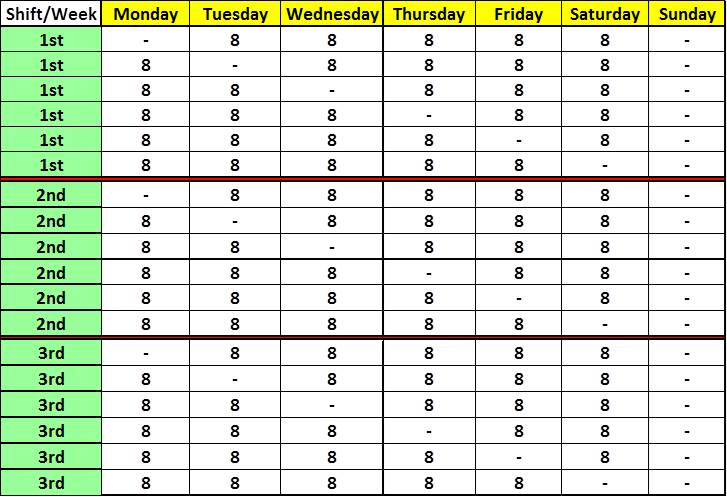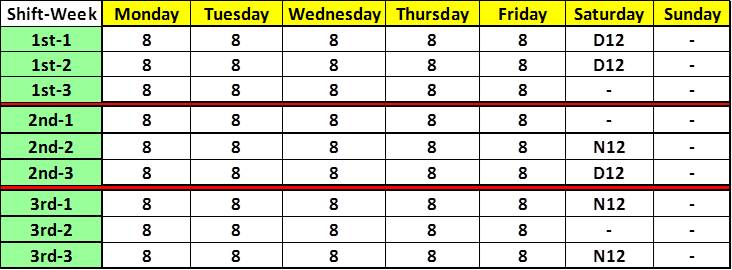Sometimes companies are born into a 24/7 schedule. An example would be a refinery. From the moment it was conceived until it reached operational retirement, it was a 24/7 operation. There are many examples like this.
More often than not, 24/7 schedules are something that companies grow into. They start off covering one or two shifts during the week. As they expand, they add more shifts; more hours of productivity. It’s these companies that I’d like to talk about today. More specifically, I’d like to talk about the murky waters of 6-day operations that companies often wade through as they transition from a 5-day workweek to a 7-day workweek.
I use the term “murky waters” because there is no easy path when you are sitting on the cusp; when 5 days a week is too little and 7 days a week too much.
People don’t think about this much until they get there. Only then does the reality of their situation set in. That reality is: There are no good 6-day schedules.
That may actually be a little judgmental as “good” is in the eye of the beholder and I can certainly name a few companies we’ve worked with where a 6-day schedule was perfect for both – operations and the workforce. However, in the vast majority of 6-day operations, the options are few and not very attractive.
Let’s look at this first from a staffing perspective.
A schedule that covers 24 hours a day, Monday through Friday is a 120-hour schedule. That is, it covers 120 hours of the week from when it starts to when it finishes. This is an important number since we need to hire people to cover those hours every week. A 120-hour schedule uses three crews, each working 40 hours a week on average (note: There are 3-crew, 12-hour schedules that average 40 hours by working 36 hours twice and 48 hours once in a 3-week cycle). So, once you have your three crews, you are ready to go.
A schedule that covers 24 hours a day, every day of the week (24/7) will use four crews. This is because there are 168 hours in a week. If you divide those hours among 4 crews, each crew will get 42 hours on average (note: Using 8’s, their weekly hours will be 40, 40, 40 and 48. Using 12’s, half the weeks will have 36 hours and half will have 42 hours.)
So, if a 5-day schedule uses 3 crews and a 7-day schedule uses 4 crews, where does that leave us with a 6-day schedule?
The answer is, we need 3.6 crews to cover 24 hours a day, 6-days a week. This is true if the average workweek is 40 hours.
The complexity of this type of crewing will be covered in the next blog post which I will post in a few days. Suffice to say, partial crews raise all types of issues with supervision, rotation, and cross-training.
Now let’s look at the operational issues.
The single biggest problem is maintenance. Depending on your facility and industry, there can be several similar types of issues like sanitation or changeovers and such. I’ll just discuss maintenance here because it is a fairly universal problem with 6-day schedules.
For the purpose of this discussion, I’m going to assume that you must turn over your equipment to maintenance for one shift per week.
When a company runs 5 days a week, maintenance is inevitably pushed to the weekends. This may not be good for the maintenance people who have to work every Saturday and Sunday, but it allows the largest portion of the workforce, those not in maintenance, to have the weekend off. The good news is that maintenance will have 2 full days to get all of their work done before operations start back up on Monday.
When a company makes the leap to 7-day operations, maintenance opportunities actually improve. Instead of trying to get everything fixed on a weekend, maintenance can now get access during the week. Why? Because maintenance has to be done and there is no longer any compelling reason to do it on the weekends. So, why not start doing your maintenance when there are vendors, outside shops, engineers and supervision more readily available. In short, maintenance is better done on the weekdays than on the weekends. If you are going to lose a shift of operations to maintenance at some point in the week, pick that shift where maintenance is better accomplished.
Now we get to the 6-day schedule. Operations will make the case that they need to run 6 days so maintenance should do their work on Sunday. If you do maintenance anywhere other than Sunday, this means a productive shift is lost that must be replaced and the only place to add it back is…Sunday. The choice becomes (1) maintenance on Sunday or (2) maintenance not on Sunday and the workforce comes in for a shift on Sunday to make up for the one lost to maintenance during the week. Since the largest portion of the operation is not made up of maintenance people, they win and thus, get Sundays off. This means maintenance is now saddled with doing a week’s worth of work in a single, weekend day.
Depending on the size of your plant, the scope of your maintenance and the reliability of your equipment, this may simply not be achievable. You may not have enough maintenance people at your facility to do all of the work that needs to be done in a single day. Maintenance will do their best but still, shortcuts may be the tool of last resort. If your equipment is highly sensitive to partial maintenance, then it will begin to shut itself down during the week in protest of the lack of attention it got on the weekend.
Maintenance may add more people to their crews in an attempt to have more people available on the weekend. This may actually work but can also result in overstaffing during the weekdays when everything is running and only corrective maintenance or project work can get done.
Maintenance may resort to using a Weekend Crew so they can add people without overstaffing during the week. This may also work, however since Sunday is only one day and a weekend crew is, at the very least, a 2-day crew, you will still end up being overstaffed on Saturday when everything is still running.
So there you have it. Staffing-wise, 6-day schedules are mathematically complex. Operational-wise, you are out of room to do the support work that most operations require to run reliably.
In my next posting, I will cover schedules that address these issues with varying degrees of success.
Call Us and We Can Help
Call or text us today at (415) 858-8585 to discuss your operations and how we can help you solve your shift work problems. You can also complete our contact form and we will call you.
See more blog posts:
6-day schedules (part 2)
6-day schedules (part 3)
6-day schedules (part 4)






